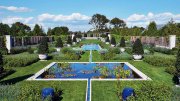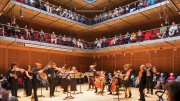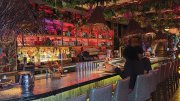In the Gilded Age, Newport, Rhode Island, became the summer playground of the American upper class. Vanderbilts and Astors built mansions (“cottages”) along Bellevue Avenue, each trying to outshine the others in magnificence. Yet, flying in the face of this craze, Arthur Curtiss James, whose riches derived from the mining and railroad industries, and his wife, Harriet Parsons James, by 1908 had instead acquired 35 rugged acres on the southern part of Newport’s home, Aquidneck Island. To be sure, they enlarged a mansion there, and added a tennis court, stables, a garage, a carriage house, multiple pools, and even a telescope house. (Eventually, they owned the largest estate in Newport.) But the quiet, relatively modest Jameses made their real mark on the town by creating one of America’s great private residential landscapes: the Blue Garden (thebluegarden.org), which is now open for tours on Thursdays from June 9 to October 6.
The couple retained Frederick Law Olmsted Jr., A.B. 1894, namesake son of the “father of landscape architecture,” to plan their estate with his firm, Olmsted Brothers. (In 1900, Olmsted Jr., known as “Rick,” had developed the curriculum for Harvard’s first formal program in landscape architecture.) “The Blue Garden is not typical of Olmsted work,” says Sarah Vance, M.L.A. ’88, director of The Blue Garden since 2014, “but the site-planning is. It’s the largest Gilded Age garden in Newport, and people are fascinated by the monochromatic palette.”
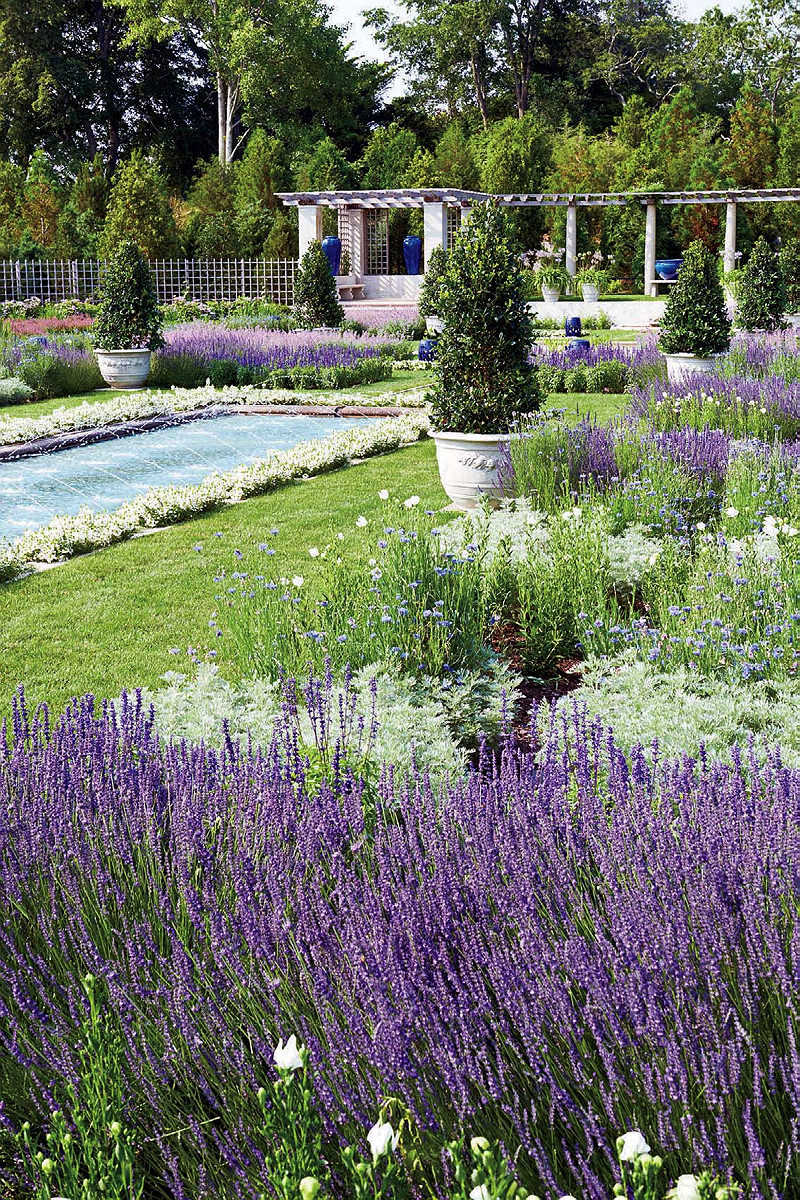
Formal color coordination and stalwart enclosures create a sense of serenity at this botanical refuge.
Photograph ©Marianne Lee Photography/Courtesy of the Blue Garden
In The Blue Garden: Recapturing an Iconic Newport Landscape (2019), Arleyn A. Levee, M.A.T. ’65, sedulously describes the garden’s origins, effulgence, decline, fall, and ultimate renaissance.
It began with a bang. On August 15, 1913, the Jameses gave a spectacular party, “The Masque of the Blue Garden,” as an opening celebration of their azure plot. On a moonlit summer night, 350 costumed guests arrived to witness a dazzling classical pageant that involved 54 actors, dancers, and musicians. “The cast even included the crew of James’ yacht Aloha II performing as Neptune’s followers,” says Levee, adding that after the theatrics, the numerous costumed staff served a Renaissance banquet of boar and fruits at the mansion. A forest of twinkling electric blue bulbs formed the backdrop for the actors and dancers who cavorted for 45 minutes among the shrubs, flowers, and even in the pools, all capped off with an interpretive dance by the scantily clad classical dancer Florence Noyes, who climaxed her performance by disappearing into the square lily pond. For the next 20 years, the Jameses’ Blue Garden events—often with a philanthropic mission—shone brightly on the Newport social scene.
The garden itself rests on a classic formal axial design; from above, its layout resembles the floor plan of a cathedral. Yet the Blue Garden “remains a unique expression of the art of landscape architecture,” says Levee. “It was blasted from the surrounding terrain of windswept jagged moors that were layered with enormous rocky extrusions.” The blasting created a level plane for the garden, but, Levee says, “it spared surrounding glacial erratics and sedimentary rocks” and preserved what the Jameses called, after Alexander Pope, “the genius of the place.” Harriet James also specified a rare color scheme limited to blue and purple flowers. The Blue Garden today remains blue with a roughly equal mix of perennials and annuals. The latter, Vance explains, “ensure that blue plants will be in flower all summer long.”
Protected by a border of trees and shrubs, the Blue Garden qualifies as a garden “room.” Yet unlike nearby Newport estates, no imposing trees or sculptures line its entryway; the Blue Garden is a hortus conclusus (“enclosed garden”) with pergolas at opposite ends, its opulence revealed only to those inside its walls. It’s a kind of hidden treasure chest, stuffed with riches from the plant kingdom.
The many species that the Olmsted firm and Mrs. James selected include, to start the season, Allium azureum (blue onion), blue Delphinium (larkspur), and Centurea cyanus (cornflower). In midsummer, Hydrangea, Iris, Gentiana, and Lavendula (lavender) come into flower. Asters and Ageratum bloom in late summer, while annuals and evergreen plants like Plumbago auriculata (leadwort) bring color all season long.
In 1941, the Jameses died within three weeks of each other, and their high-maintenance estate fell into desuetude. (Arthur James was then among the country’s 10 richest men, but he shunned publicity, including for charitable contributions. He and Harriet left most of their fortune to hospitals, universities, and nonprofits.) The Diocese of Providence received the property as a gift in 1951 and converted some buildings into schools and a convent. A 1967 fire destroyed much of the mansion, which was eventually demolished. Meanwhile weeds and invasive vines overran the terrain.
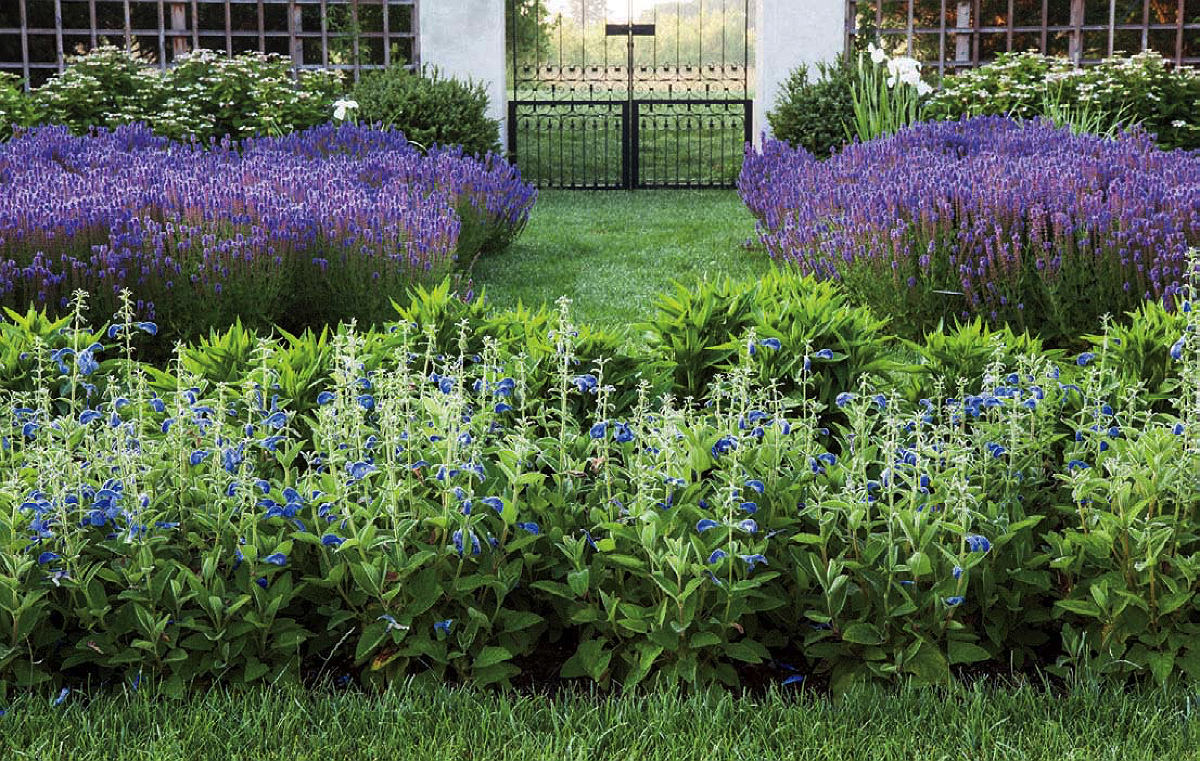
Billowing mass plantings that lend the landscape a romantic sensibility
Photograph ©Millicent Harvery/Courtesy of the Blue Garden
Beginning in 1984, Harriet Jackson Phelps, photographic editor of the Garden Club of America’s Bulletin, accidentally happened on boxes of glass slides taken of famous American gardens of the 1920s and 1930s. She launched a “garden archeology” of Newport, “wading through waist-high weeds on various sites,” as Levee reports, and revealed “the tattered walls, columns, pools, and rills of the Blue Garden.”
In 2012, Newport resident and philanthropist Dorrance Hill Hamilton, an heiress of the Campbell Soup fortune, at age 84 built herself a new house on 3.2 acres adjoining the site. Vance recounts that, having long known of the Blue Garden’s history, she declared, “Let’s buy it and bring it back to its original glory.”
Working from original plans, photographs, and documents from the Olmsted National Historic Site in Brookline, Massachusetts, and from the Library of Congress, the landscape architecture firm Reed Hilderbrand and the general contractor Parker Construction restored much of the original Blue Garden design, including its structures, using lower-maintenance modern plantings. Levee quotes Mrs. Hamilton to the effect that, “I’m not going to have 60 gardeners to maintain this place, so we need to make sure the beauty and artistry are sustainable.”
And so it is. This year marks the bicentennial of the birth of Frederick Law Olmsted Sr., A.M. 1864, LL.D. ’93. In 1885, it was he who designed the roads and lot layouts that made this part of Aquidneck Island into developable terrain. So it’s an especially appropriate time to take in the Blue Garden’s magnificence.
